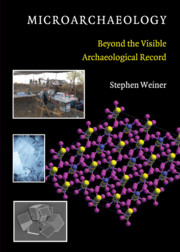Book contents
- Frontmatter
- Contents
- Preface
- 1 Archaeology, Archaeological Science, and Microarchaeology
- 2 Information Embedded in the Microscopic Record
- 3 Completeness of the Archaeological Record
- 4 Common Mineral Components of the Archaeological Record
- 5 Biological Materials: Bones and Teeth
- 6 Biological Materials: Phytoliths, Diatoms, Eggshells, Otoliths, and Mollusk Shells
- 7 Reconstructing Pyrotechnological Processes
- 8 Biological Molecules and Macromolecules: Protected Niches
- 9 Ethnoarchaeology of the Microscopic Record: Learning from the Present
- 10 Absolute Dating: Assessing the Quality of a Date
- 11 Reading the Microscopic Record On-Site
- 12 Infrared Spectroscopy in Archaeology
- Appendix A Identifying Minerals Using Microchemical Analysis
- Appendix B Identifying Minerals and Compounds Using Infrared Spectra: Table of Standard Minerals and Compounds for Which Infrared Spectra Are Available
- References
- Index
- Plates section
10 - Absolute Dating: Assessing the Quality of a Date
Published online by Cambridge University Press: 05 June 2012
- Frontmatter
- Contents
- Preface
- 1 Archaeology, Archaeological Science, and Microarchaeology
- 2 Information Embedded in the Microscopic Record
- 3 Completeness of the Archaeological Record
- 4 Common Mineral Components of the Archaeological Record
- 5 Biological Materials: Bones and Teeth
- 6 Biological Materials: Phytoliths, Diatoms, Eggshells, Otoliths, and Mollusk Shells
- 7 Reconstructing Pyrotechnological Processes
- 8 Biological Molecules and Macromolecules: Protected Niches
- 9 Ethnoarchaeology of the Microscopic Record: Learning from the Present
- 10 Absolute Dating: Assessing the Quality of a Date
- 11 Reading the Microscopic Record On-Site
- 12 Infrared Spectroscopy in Archaeology
- Appendix A Identifying Minerals Using Microchemical Analysis
- Appendix B Identifying Minerals and Compounds Using Infrared Spectra: Table of Standard Minerals and Compounds for Which Infrared Spectra Are Available
- References
- Index
- Plates section
Summary
An absolute date is probably the most important information that can be obtained from the microscopic record in terms of contributing to the overall understanding of an archaeological site. Relative dating based on typologies of ceramics, coins, stone tools, glyptic objects, and epigraphic texts is still the most widely used approach for building a chronology within a site and between sites. Linking this chronology to the absolute timescale is now standard practice and essential for defining local and regional chronological frameworks. This information, in turn, can be used to track the spread of cultural changes and, in this way, significantly enhance our understanding of human cultural development.
For periods up to about 50,000 years, almost all absolute dating is based on radiocarbon – a method developed by Libby et al. (1949). For earlier periods, three related techniques, together known as trapped charge dating (Grün, 2001), are commonly used. These are thermoluminescence (TL) dating, developed by Aitken (1976); electron spin resonance (ESR) dating, developed by Zeller (1968) and Ikeya (1978); and optical stimulated luminescence (OSL), developed by Huntley et al. (1985). There are, in addition, a variety of other absolute dating techniques, some of which are applicable to materials found within an archaeological site, and some of which are used for dating mainly rock formations, speleothems, or sediments underlying or overlying the site. Table 10.1 lists the main dating techniques used in archaeology.
- Type
- Chapter
- Information
- MicroarchaeologyBeyond the Visible Archaeological Record, pp. 245 - 260Publisher: Cambridge University PressPrint publication year: 2010



